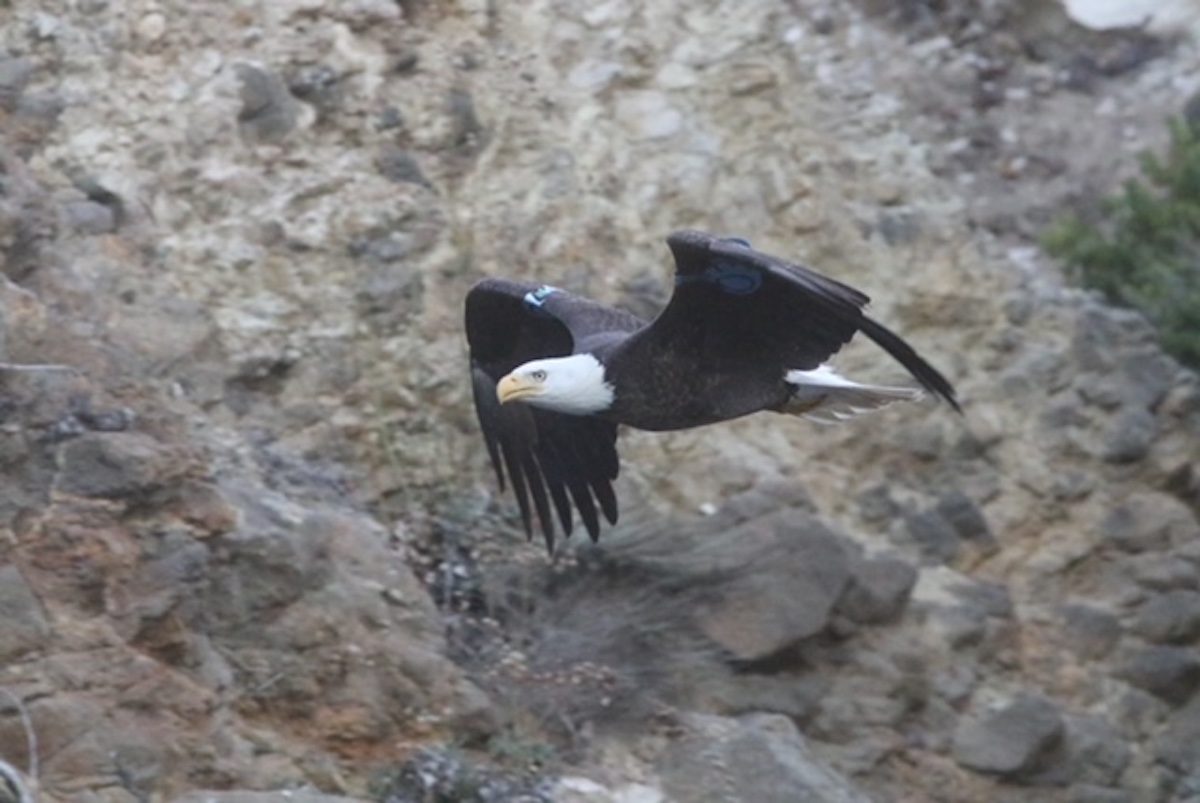The Channel Islands’ Bald Eagle Brothers
A-04, the Shyest of the Siblings, Is Spotted at San Miguel Island

As we dodged northwest swell while kayaking around Castle Rock, Point Bennett, and the pocket beaches of San Miguel Island, we could hear the barks, bellows, and snorts of crowded pinniped colonies. However, once we arrived at Cardwell Point, it wasn’t the marine mammals that garnered our attention. It was a mature bald eagle that had us all sitting up straight in our kayaks.
The eagle had the customary blue wing tags that many possess in the Channel Islands National Park. They’re also equipped with a Global Positioning System (GPS). I yanked my binoculars out of my drybag and honed in on the steely eyed bird. It was then I got a bead on its number ― A-04, a 6-year-old male.
A-04 is the rarely seen, low-key brother of A-02 and A-03. “A-04 is a male from the 2017 Fraser Point nest,” said Dr. Peter Sharpe with the Institute for Wildlife Studies, which has been instrumental in returning bald eagles to the Channel Islands since 2002. “We have not been out on San Miguel” ― the most remote of the three northern isles ― “since 2017, so we have no idea what is going on there with eagles.” Part of that inactivity was due to the COVID-19 pandemic, when monitoring these majestic raptors took a backseat.
The nest at Fraser Point has been active for some time now. It overlooks a sweeping marine terrace that extends northwest toward the Santa Cruz Passage and eventually Santa Rosa Island. Bald eagles are monogamous raptors. Their mother is appropriately named “Cruz.” Their father has since passed. Their mother has taken up with another male, and they have reared more eaglets from the same nest at Fraser Point.
Sign up for Indy Today to receive fresh news from Independent.com, in your inbox, every morning.
The three brothers have now fanned out across the Northern Chain, establishing their own territories on Santa Cruz, Santa Rosa, and San Miguel Islands. The most well-known of the siblings is A-03. Since February 2021, he has become a bit of a celebrity while establishing his territory around the Scorpion Anchorage region on the southeast fringe of Santa Cruz. He is seen regularly by visitors hiking and kayaking the area, often on the volcanic crags that serve as his favorite perches.
Their nest from which they fledged is one of many established across the Northern Chain. Since bald eagle recovery began on the National Park in 2002, the birds have reclaimed historic swaths of territory. One pair nesting in Pelican Canyon has remained together for nearly 17 years. One of the eagles is from the park, and the other is from Catalina Island.
“We have 12 known pairs of breeding bald eagles on the Northern Channel Islands, and then multiple younger or non-breeding birds (probably 10-plus),” continued Sharpe. “They also produced about 14 fledglings, which should still be on the islands, so there are currently around 50 eagles on the Northern Channel Islands.”
In 2021, eight of those nests were on Santa Cruz. Another was on Anacapa, and three more were active on Santa Rosa. With A-03 entrenched at Scorpion Anchorage, it is hoped that a nest will be established there in the near future. It would be a first at the busy anchorage. The next closest nest to the south is located at Yellow Banks, and the next to the northwest is the one at Pelican Canyon.
In 2022, A-02 made his first nesting attempt on Santa Rosa Island with its mate. The young pair were unsuccessful, a common occurrence for first-time parents. However, the three brothers’ expansion signifies continued growth of the bald eagle population, a keystone species solidifying natural balance across the Channel Islands.
Support the Santa Barbara Independent through a long-term or a single contribution.



